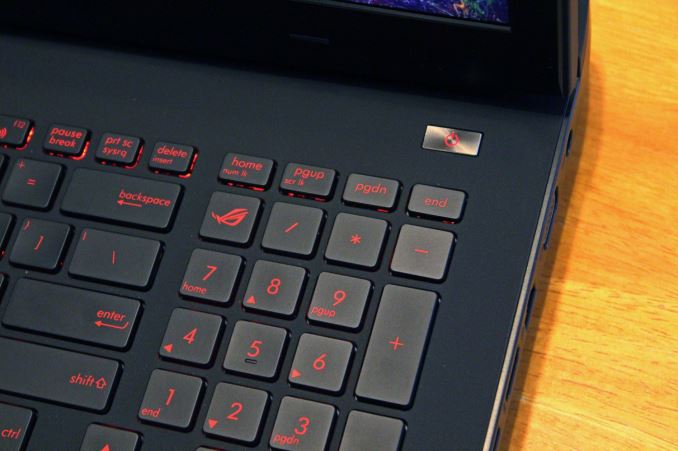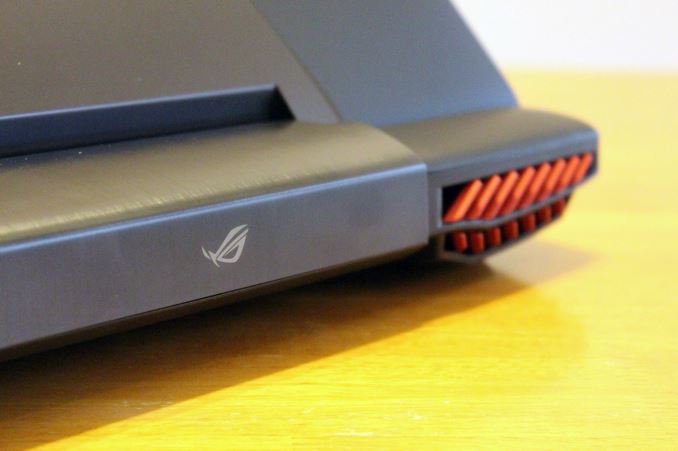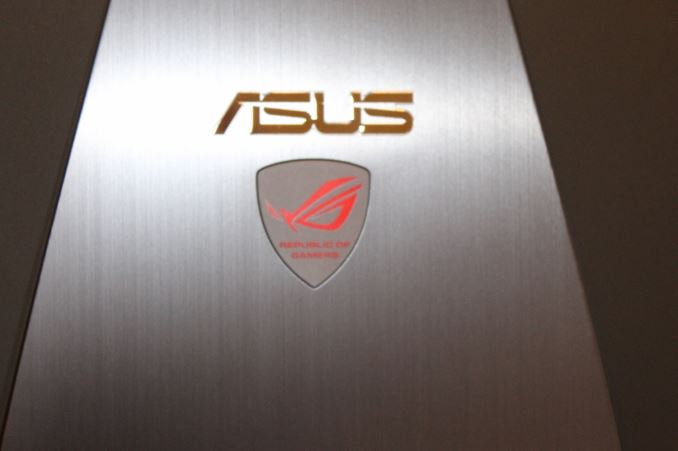The ASUS Republic of Gamers G751 Review: G-SYNC Comes To The Notebook Computer
by Brett Howse on July 29, 2015 8:30 AM ESTFinal Words
Evaluating the ASUS G751 is my first opportunity to use G-SYNC when gaming, and to that end G-SYNC has certainly lived up to its billing. Some of that would also be the very powerful hardware that ASUS has packed into the G751. The GTX 980M continues to impress, and in a device of this size, cooling is not an issue. The other part of the smoothness when gaming though is ASUS’s decision to include a 75 Hz IPS panel. The combination of G-SYNC with this panel makes practically any gaming scenario a silky smooth experience.
The package has some hits and misses. The keyboard and trackpad are quite good, and I’ve already praised the IPS panel which in addition to the 75 Hz refresh rate, has decent color accuracy and contrast. It’s a big step up from the TN panels which can still be found in some gaming notebooks. ASUS has also included plenty of connections including four USB 3.0 ports and a network port. On the miss side is, at least in my opinion, the styling. The G751 seems to have been styled against gaming laptops from a couple of years ago, and hasn’t moved to a sleeker form factor with more premium materials than plastic. Some of that may have been costs though, since ASUS is trying to offer a powerful system at a better price.
The thicker form factor and massive weight of this notebook certainly reduce its portability, and that is further hampered by the poor battery life, which is dragged down by the lack of Optimus support. But for the target audience this is going to likely be the least important criticism. The benefit of no Optimus is G-SYNC support, which on a device like this is certainly the right trade-off.
At this point, all of the hardware inside of the G751 is pretty well known, but that doesn’t take back what it does. The Core i7-4720HQ processor is plenty powerful for most tasks, and while it would have been nice to see ASUS upgrade it to the Broadwell parts, it’s hard to fault them since the quad-core Broadwell upgrade was pretty late in coming. The NVIDIA GTX 980M is the star of the show, as it tends to be, offering some pretty impressive gaming performance in a portable notebook. ASUS has also outfitted the G751 with 24 GB of memory in this model, and they offer an upgrade with 32 GB as well. The included storage is very fast, and it’s great to see them make the move to PCIe based storage. The XP941 is a very quick drive and storage speeds should not ever be an issue. For those that need more flash storage, ASUS does offer a 512 GB version as well as the 256 GB model sampled. The days of the optical drive seem to be numbered, but it’s handy to have a Blu-Ray burner available, and I’ve already used it a few times.
One of the strongest features of the G751 is the cooling system, which seems to pretty easily handle the heat output of the CPU and GPU, but it does this while maintaining a relatively quiet sound levels. It really is quite amazing to be gaming on a system this powerful, and while you can hear the fans, the output and frequency are both low enough to not really bother you. Most gaming laptops are almost always going to need headphones, but the G751 is certainly the quietest gaming notebook that I have encountered.
Overall, I’ve really enjoyed my time with the ASUS G751. It offers plenty of power, a good display, and is among the first laptops to offer the supurb game smoothing capabilities of G-SYNC. It is certainly not inexpensive at $2150 as tested, to $2650 (MSRP) with a faster CPU and double the SSD storage, but it comes in at a good price for a system with this much performance. Online, you can find the as-tested model for $1900 at Amazon, which is a good chunk of change less than the MSRP and really adds to the value of this offering. To me, the one real downside is the styling, but that’s one thing that is really up to the individual. The combination of G-SYNC, a 75 Hz IPS panel, and the GTX 980M make this an incredibly potent gaming notebook.













52 Comments
View All Comments
Notmyusualid - Saturday, August 1, 2015 - link
^ Also this is true.Guys in work bemoanded my M3800 purchase back in December due to only having Haswell, and supposedly Broadwell was due out any day... But a machine was required immediately.
Broadwell shipped 8 months later, and in no numbers too! I'm not ever buying a 'U' Intel cpu, so those don't count.
Turns out my instinct (likely due to places like this), was right.
BMNify - Wednesday, July 29, 2015 - link
Around the corner?? Skylake H mobile will take atleast 6 months before launching in a new product like this, people buy when they need and don't wait half a year for updates.shadowjk - Wednesday, July 29, 2015 - link
Exactly. I'm still on 4700MQ + 780M.With "Skylake around the corner", nobody seems to want to sell even the few Broadwell-H laptops that allegedly exist, atleast in Europe. I'm guessing we'll be stuck on Haswell another 9-16 months..
boeush - Wednesday, July 29, 2015 - link
My guess is, nobody wanted to invest in Broadwell H inventory, when Skylake is soon to render it obsolete. OEMs are simply waiting for Skylake to refresh their models; they are skipping Broadwell pretty much just as Intel did.Refuge - Thursday, July 30, 2015 - link
Yes, this. No OEM's are paying Broadwell much mind. It was a flubbed launch when you look at its placement in the timeline. Timing was all wrong.Intel shouldn't have even bothered with it if they weren't going to push back Skylake, but oh well. At least the limited it to a very small launch.
douglord - Wednesday, July 29, 2015 - link
Totally pointless system for anyone that's not an engineer or architect that has to be able to take 3D drawings to customers.Why can't we get a 4 Core 45w chip with Iris Pro in a 5lb 15" laptop with all day battery life (10 hours)?
No we have to choose between a pointless 10lb gayming system with 1 hour battery life and 2 core ULP garbage in a 2lb folder.
BMNify - Wednesday, July 29, 2015 - link
I doubt you even read the article's first paragraph before commenting here, You are blabering about Engineers and architects and ignoring the name of the product itself: "Republic of Gamers", Hope you got a clue and its gaming not gayming. Hope i didn't hurt your gay feelings, homophobic people generally are just hiding their own insecurities and can be cured with proper help in coming out of the closet.Notmyusualid - Saturday, August 1, 2015 - link
doug sounds clueless to me.benzosaurus - Wednesday, July 29, 2015 - link
I believe the low-end Retina Macbook Pro is exactly the machine you're describing.boeush - Wednesday, July 29, 2015 - link
As an engineer (SW) who periodically deals with 3D graphics and modeling, I wouldn't bother with any 16:9 screen no matter the resolution. 16:10 is the minimal aspect ratio that is remotely acceptable for a workstation. 1080p is only suitable for movie watching, and is counter-productive for anything else.